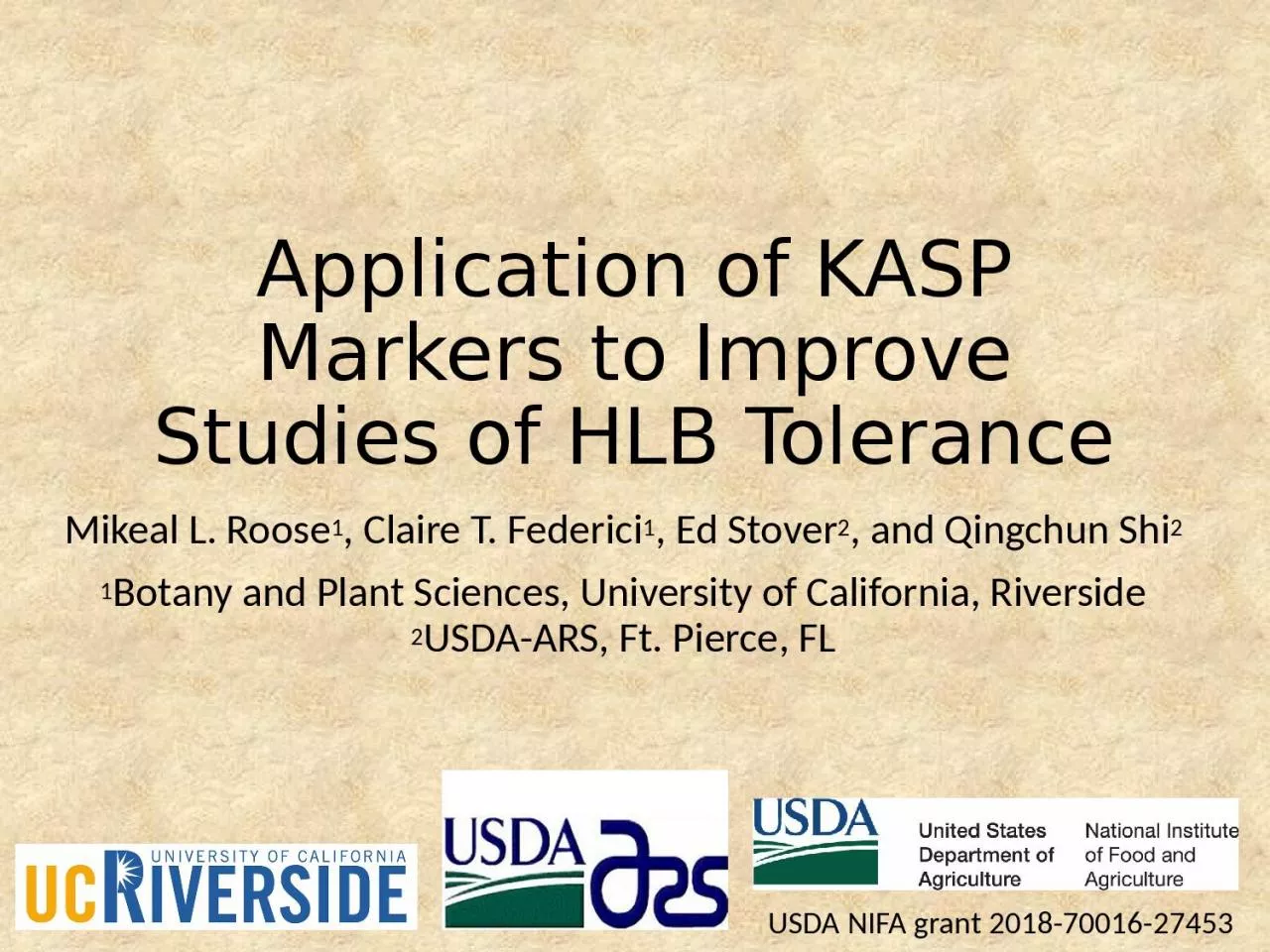

Mikeal L Roose 1 Claire T Federici 1 Ed Stover 2 and Qingchun Shi 2 1 Botany and Plant Sciences University of California Riverside 2 USDAARS Ft Pierce FL USDA NIFA grant 20187001627453 ID: 1043329
Download Presentation The PPT/PDF document "Application of KASP Markers to Improve S..." is the property of its rightful owner. Permission is granted to download and print the materials on this web site for personal, non-commercial use only, and to display it on your personal computer provided you do not modify the materials and that you retain all copyright notices contained in the materials. By downloading content from our website, you accept the terms of this agreement.
1. Application of KASP Markers to Improve Studies of HLB ToleranceMikeal L. Roose1, Claire T. Federici1, Ed Stover2, and Qingchun Shi21Botany and Plant Sciences, University of California, Riverside2USDA-ARS, Ft. Pierce, FLUSDA NIFA grant 2018-70016-27453
2. Genotyping seedlings to improve analysis of breeding materialObjective – to improve analysis of experiments in which the parent tree is evaluated based on seedling populations Problem – the % nucellar seedlings produced by parent trees is variable and often unknownNucellar seedlings will be more uniform than zygotics so the % nucellar seedlings will affect the mean and variance of each “family” evaluatedExamples: HLB screening of diverse germplasm or mapping populationsField or greenhouse experiments to evaluate potential rootstocks for disease tolerance (CTV, citrus nematode, HLB etc.) based on seedlings
3. Choice of MarkersFirst experiments – used isozymes to test genotype of trees in rootstock trials (Roose and Traugh, 1988)Many options: CAPS, SSRs etc. but labor cost is highOutsourcing marker analysis may be cost effective because companies use robots, micro-scale assaysKASP markers – a common SNP system based on allele-specific PCR to generate codominant markers in plate format (no gel analysis)LGC (and other companies) can analyze these for relatively low cost per sample, including DNA isolation ($5.55 for 15 SNPs)Design of markers – select informative SNPs based on parent genotypes determined with Affymetrix SNP array. More than 90% of designed markers work as expected. Primers can include mixed bases to address “second SNP” sites
4. Application to HLB Screening ExperimentField experiment at USDA Farm, Ft. Pierce FLMaterial tested – 734 trees in randomized design490 surviving seedlings from 133 trees in Fortune x Fairchild mapping population at UCR (some source trees are duplicates)Seedlings from 28 selections: several Ponkan types, other Florida selectionsControls – 14 Valencia and 6 Hamlin sweet orange seedlingsTrees planted in field in June 2015, sampled in 2018 (29% dead)Leaf disc samples lyophilized and sent to LGC for analysisUsed 15 SNP markersDistributed over all 9 chromosomesMap near chromosome endsSelected to be polymorphic in mandarin group
5. SNP calls can be evaluated for confidence in free viewer
6. ResultsFew (0.7 %) no callsCompare genotypes of Florida seedlings with LGC and Affymetrix array calls for same SNP in parent trees at UCRClassify each seedling asNucellar – all called loci match parentZygotic:outcross – seedling has marker allele not found in maternal parentZygotic – seedling does not match maternal parent but has no alleles not found in mother tree (possible self)Mixup – seedling has a genotype apparently incompatible with supposed mother e.g.: mother A:A, seedling C:C
7. Examples of data for specific trees5 nucellarseedlings10 zygoticseedlings7 nucellar1 mixupseedlingColor corresponds to SNP base call in table below15 SNP loci---------------------------------------------------Parenttree
8. Assessment of ConfidenceNumber of loci differing from parentNumber of Seedlings0 (nucellar)1791425374205576497818599401014>103Total progeny518Nearly all zygotic progeny are identified as such by several lociMean number of loci differing from parent is 6.68Duplicate source trees nearly always give similar resultsFortune – 25/25 seedlings are Zygotic-outcross (as expected)Valencia and Hamlin – all nucellar except one mixupMost “Ponkan types” highly nucellar (some are variants, not Ponkan clones)Below is mostly Fortune x Fairchild progeny data
9. SummarySeedling OriginTotal Counts (all trees)Nucellar338Zygotic:outcross344Zygotic 6Mixup 41Possible Origins of MixupsSeed from different trees mixed Wrong tree sampled – match to adjacent treeMixup in nursery – e.g. FxF progeny has genotype of ValenciaLeaf discs mixed during sampling Genotyping error – unlikely for most
10. Classification of FxF Maternal TreesSeedlings produced Count> 90% nucellar1420-90% nucellar17100% zygotic36Only 1 seedling10Only a few seedlings survive for some maternal trees so this is not an accurate assessment of segregation for nucellar embryony
11. Application of Seedling Genotypes to HLB Tolerance AnalysisIf population of parents and seedlings is large, and most have NE, analyze only nucellar seedlings (not in our population)In QTL analysis, weight nucellar seedling scores as 2 and those of zygotic:outcross seedlings as 1 (based on % genes shared)When QTLs found, seedlings can be genotyped for these candidate markers and improved models developed
12. Conclusions and Prospects12-15 selected SNP markers is usually sufficient to identify zygotic seedlingsProcedure is fairly straightforward and probably worthwhile for otherwise expensive experimentsActual value is difficult to assess until we analyze data with and without adjustments for seedling genotypesHuman error (in seed collection, extraction, propagation, tree planting, or leaf sample collection) likely accounts for most “mixup” seedlingsSNP markers are somewhat population-specific. We use different marker sets for oranges-mandarins vs trifoliates. Probably acid citrus also need a separate set